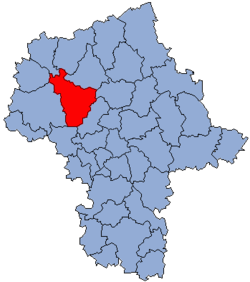Top Qs
Timeline
Chat
Perspective
Płońsk County
County in Masovian Voivodeship, Poland From Wikipedia, the free encyclopedia
Remove ads
Płońsk County (Polish: powiat płoński) is a unit of territorial administration and local government (powiat) in Masovian Voivodeship in east-central Poland. It came into being on 1 January 1999, as a result of the Polish local government reforms passed in 1998. Its administrative seat and largest town is Płońsk, which lies 63 km (39 mi) north-west of Warsaw.
The county covers an area of 1,380 km2 (530 sq mi), and consists of two urban and ten rural gminas. It is bordered by eight other counties of the Masovian voivodeship. As of 2019, the county had a population of 87,183 inhabitants, of which about 26,514 reside in the two urban areas of Płońsk and Raciąż.
Remove ads
Etymology
In the Middle Ages, the region was given by various names such as Plonz, Plonsko, Ploń, and Ploniska. There are two theories as to the origin of the name. As per the first theory, the name was derived from the Polish word "płona" or "płonia", meaning fast-flowing parts of a river. Another version states that the name came from the Slavic god Płon.[3]
History
Early archeological evidence points to the region being inhabited at least since the 6th century CE. The St. Michael church and the former monastery of the Trzewiczkowe Carmelites, were founded in the early 15th century by the Mazovian prince, Siemowit IV and his wife Aleksandra, sister of king Władysław Jagiełło. Siemowit established Plonsk as a city in the region, which was later confirmed by king Sigismund I. The region underwent further economic development in the 16th century. However, in the 17th century, the population in the region declined as a result of the Swedish Deluge.[3]
The region was occupied by the Russian Empire later. After the First World War, it became part of Poland, and Plonsk became the seat of the Plonsk district.[4] The county is the birthplace of Ben Gurion, the founder of Israel.[3] During the Second World War, the region was captured by Nazi Germany, and the region was segregated to separate the Jews from the ethnic Poles.[5]
Remove ads
Geography
Summarize
Perspective
Płońsk County is a powiat located in Masovian Voivodeship in east-central Poland.[1] It came into being on 1 January 1999, as a result of the Polish local government reforms passed in 1998.[6] Its administrative seat and largest town is Płońsk, which lies 63 km (39 mi) north-west of Warsaw.[7] The county covers an area of 1,380 km2 (530 sq mi).[1] It is bordered by Mława County and Ciechanów County to the north, Pułtusk County to the east, Nowy Dwór County to the south-east, Sochaczew County to the south, Płock County and Sierpc County to the west, and Żuromin County to the north-west.[8] The Płonka river, which is the tributary of the Vistula river, passes through the region.[4]
Administrative division
The county is subdivided into 12 gminas. These include the two urban areas of Płońsk and Raciąż and ten rural areas.[1][9]
Demographics
As of 2019, the county had a population of 87,183 inhabitants, of which about 26,514 reside in the two urban areas of Płońsk and Raciąż.[2] The county had a mixed ethnicity of ethnic Poles and Jews. Jewish settlements formed in the region in the 15th century. In the 17th century, during the reign of king Michael I, they were allowed special privileges to build houses and a synagogue. This resulted in a large influx of Jews into the county. In the early 19th century, the county was dominated by Jewish population and it had one of the largest percentage of Jewish population in the country. In the subsequent years, the Jewish population reduced due to emigration.[5]
Remove ads
References
External links
Wikiwand - on
Seamless Wikipedia browsing. On steroids.
Remove ads



